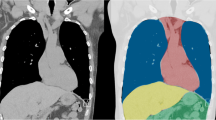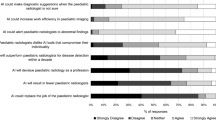Abstract
There has been an exponential rise in artificial intelligence (AI) research in imaging in recent years. While the dissemination of study data that has the potential to improve clinical practice is welcomed, the level of detail included in early AI research reporting has been highly variable and inconsistent, particularly when compared to more traditional clinical research. However, inclusion checklists are now commonly available and accessible to those writing or reviewing clinical research papers. AI-specific reporting guidelines also exist and include distinct requirements, but these can be daunting for radiologists new to the field. Given that pediatric radiology is a specialty faced with workforce shortages and an ever-increasing workload, AI could help by offering solutions to time-consuming tasks, thereby improving workflow efficiency and democratizing access to specialist opinion. As a result, pediatric radiologists are expected to be increasingly leading and contributing to AI imaging research, and researchers and clinicians alike should feel confident that the findings reported are presented in a transparent way, with sufficient detail to understand how they apply to wider clinical practice. In this review, we describe two of the most clinically relevant and available reporting guidelines to help increase awareness and engage the pediatric radiologist in conducting AI imaging research. This guide should also be useful for those reading and reviewing AI imaging research and as a checklist with examples of what to expect.


Similar content being viewed by others
References
JMAI Editorial Office (2018) Foreword. J Med Artif Intell 1:1
Kahn CE Jr (2019) Artificial intelligence, real radiology. Radiol Artif Intell 1:e184001
No authors listed (2019) More than machines. Nat Mach Intell 1:1
Davendralingam N, Sebire NJ, Arthurs OJ, Shelmerdine SC (2020) Artificial intelligence in paediatric radiology: future opportunities. Br J Radiol 94:20200975
Booz C, Yel I, Wichmann JL et al (2020) Artificial intelligence in bone age assessment: accuracy and efficiency of a novel fully automated algorithm compared to the Greulich-Pyle method. Eur Radiol Exp 4:6
Rodriguez-Ruiz A, Lång K, Gubern-Merida A et al (2019) Can we reduce the workload of mammographic screening by automatic identification of normal exams with artificial intelligence? A feasibility study. Eur Radiol 29:4825–4832
Mongan J, Moy L, Charles E, Kahn J (2020) Checklist for artificial intelligence in medical imaging (CLAIM): a guide for authors and reviewers. Radiol Artif Intell 2:e200029
Cruz Rivera S, Liu X, Chan AW et al (2020) Guidelines for clinical trial protocols for interventions involving artificial intelligence: the SPIRIT-AI extension. Nat Med 26:1351–1363
Cruz Rivera S, Liu X, Chan AW et al (2020) Guidelines for clinical trial protocols for interventions involving artificial intelligence: the SPIRIT-AI extension. Lancet Digit Health 2:e549–e560
Rivera SC, Liu X, Chan AW et al (2020) Guidelines for clinical trial protocols for interventions involving artificial intelligence: the SPIRIT-AI extension. BMJ 370:m3210
Liu X, Cruz Rivera S, Moher D et al (2020) Reporting guidelines for clinical trial reports for interventions involving artificial intelligence: the CONSORT-AI extension. Nat Med 26:1364–1374
Liu X, Cruz Rivera S et al (2020) Reporting guidelines for clinical trial reports for interventions involving artificial intelligence: the CONSORT-AI extension. Lancet Digit Health 2:e537–e548
Liu X, Rivera SC, Moher D et al (2020) Reporting guidelines for clinical trial reports for interventions involving artificial intelligence: the CONSORT-AI extension. BMJ 370:m3164
Bossuyt PM, Reitsma JB, Bruns DE et al (2015) STARD 2015: an updated list of essential items for reporting diagnostic accuracy studies. Radiology 277:826–832
Sounderajah V, Ashrafian H, Aggarwal R et al (2020) Developing specific reporting guidelines for diagnostic accuracy studies assessing AI interventions: the STARD-AI steering group. Nat Med 26:807–808
Hernandez-Boussard T, Bozkurt S, Ioannidis JPA, Shah NH (2020) MINIMAR (MINimum Information for Medical AI Reporting): developing reporting standards for artificial intelligence in health care. J Am Med Inform Assoc 27:2011–2015
Norgeot B, Quer G, Beaulieu-Jones BK et al (2020) Minimum information about clinical artificial intelligence modeling: the MI-CLAIM checklist. Nat Med 26:1320–1324
England JR, Gross JS, White EA et al (2018) Detection of traumatic pediatric elbow joint effusion using a deep convolutional neural network. AJR Am J Roentgenol 211:1361–1368
Quon JL, Han M, Kim LH et al (2020) Artificial intelligence for automatic cerebral ventricle segmentation and volume calculation: a clinical tool for the evaluation of pediatric hydrocephalus. J Neurosurg Pediatr. https://doi.org/10.3171/2020.6.Peds20251
Choi JW, Cho YJ, Lee S et al (2020) Using a dual-input convolutional neural network for automated detection of pediatric supracondylar fracture on conventional radiography. Investig Radiol 55:101–110
Larson DB, Chen MC, Lungren MP et al (2018) Performance of a deep-learning neural network model in assessing skeletal maturity on pediatric hand radiographs. Radiology 287:313–322
Zhou H, Hu R, Tang O et al (2020) Automatic machine learning to differentiate pediatric posterior fossa tumors on routine MR imaging. AJNR Am J Neuroradiol 41:1279–1285
Radiological Society of North America, American College of Radiology (2021) Common data elements (CDEs) for radiology. https://RadElement.org. Accessed 10 Feb 2021
Abadi M, Agarwal A, Barham P et al (2015) TensorFlow: large-scale machine learning on heterogeneous systems. arXiv:1603.04467
Kingma D, Ba J (2015) Adam: a method for stochastic optimization. arXiv:1412.6980
Park HS, Jeon K, Cho YJ et al (2020) Diagnostic performance of a new convolutional neural network algorithm for detecting developmental dysplasia of the hip on anteroposterior radiographs. Korean J Radiol 22:612–623
Zheng Q, Shellikeri S, Huang H et al (2020) Deep learning measurement of leg length discrepancy in children based on radiographs. Radiology 296:152–158
Quon JL, Bala W, Chen LC et al (2020) Deep learning for pediatric posterior fossa tumor detection and classification: a multi-institutional study. AJNR Am J Neuroradiol 41:1718–1725
Acknowledgments
O.J.A. is funded by a National Institute for Health Research (NIHR) Career Development Fellowship (NIHR-CDF-2017-10-037). This article presents independent funded research — the views expressed are those of the authors and not necessarily those of the National Health Service, NIHR, Medical Research Council, Royal College of Radiologists or the UK Department of Health.
Author information
Authors and Affiliations
Corresponding author
Ethics declarations
Conflicts of interest
None
Additional information
Publisher’s note
Springer Nature remains neutral with regard to jurisdictional claims in published maps and institutional affiliations.
Rights and permissions
About this article
Cite this article
Meshaka, R., Pinto Dos Santos, D., Arthurs, O.J. et al. Artificial intelligence reporting guidelines: what the pediatric radiologist needs to know. Pediatr Radiol 52, 2101–2110 (2022). https://doi.org/10.1007/s00247-021-05129-1
Received:
Revised:
Accepted:
Published:
Issue Date:
DOI: https://doi.org/10.1007/s00247-021-05129-1




